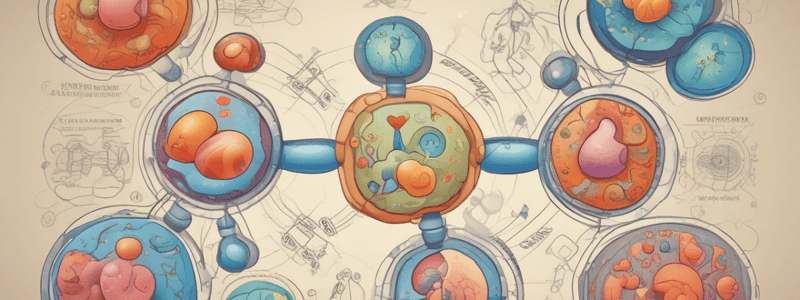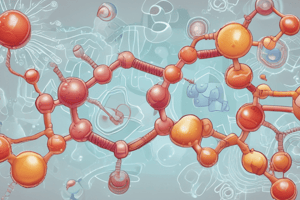Podcast
Questions and Answers
Where is most of the glycerol 3-phosphate synthesized in animals?
Where is most of the glycerol 3-phosphate synthesized in animals?
- Muscles
- Adipocytes
- Seeds and nuts
- Liver and kidney (correct)
What is the primary source of glycerol 3-phosphate in animals?
What is the primary source of glycerol 3-phosphate in animals?
- TAGs degradation
- Glycogen breakdown
- Dihydroxyacetone phosphate from glycolysis (correct)
- Glycerol kinase
What is the role of glycerol kinase in animals?
What is the role of glycerol kinase in animals?
- To convert glycerol to glycerol 3-phosphate (correct)
- To synthesize glycerol 3-phosphate from dihydroxyacetone phosphate
- To synthesize phospholipids
- To break down TAGs
In which cells is glycerol kinase absent?
In which cells is glycerol kinase absent?
What is the backbone of triacylglycerides and phospholipids?
What is the backbone of triacylglycerides and phospholipids?
What is the typical fat storage in a 70-kg human?
What is the typical fat storage in a 70-kg human?
How long can a human survive on stored fat?
How long can a human survive on stored fat?
What is the comparison of fat storage to glycogen storage in the human body?
What is the comparison of fat storage to glycogen storage in the human body?
What is the effect of high levels of free fatty acids in blood on glucose utilization in muscle?
What is the effect of high levels of free fatty acids in blood on glucose utilization in muscle?
What is the role of thiazolidinediones in type 2 diabetes treatment?
What is the role of thiazolidinediones in type 2 diabetes treatment?
What is the effect of thiazolidinediones on PEP carboxykinase synthesis?
What is the effect of thiazolidinediones on PEP carboxykinase synthesis?
What is the effect of thiazolidinediones on TAGs resynthesis?
What is the effect of thiazolidinediones on TAGs resynthesis?
What is the first step in the biosynthesis of phospholipids?
What is the first step in the biosynthesis of phospholipids?
What is the location of phospholipid biosynthesis in the cell?
What is the location of phospholipid biosynthesis in the cell?
What is the final step in the biosynthesis of phospholipids?
What is the final step in the biosynthesis of phospholipids?
What is the fate of phospholipids after their biosynthesis?
What is the fate of phospholipids after their biosynthesis?
What percentage of free fatty acids released by lipolysis are reesterified to form TAGs?
What percentage of free fatty acids released by lipolysis are reesterified to form TAGs?
What is the primary role of glyceroneogenesis in the TAG cycle?
What is the primary role of glyceroneogenesis in the TAG cycle?
During lipolysis, what is the fate of glycolysis in adipocytes?
During lipolysis, what is the fate of glycolysis in adipocytes?
What is the primary source of glycerol 3-phosphate in adipose tissue?
What is the primary source of glycerol 3-phosphate in adipose tissue?
What is the role of glycerol kinase in adipose tissue?
What is the role of glycerol kinase in adipose tissue?
What is the precursor for glycerol 3-phosphate in glyceroneogenesis?
What is the precursor for glycerol 3-phosphate in glyceroneogenesis?
What is the relationship between glyceroneogenesis and gluconeogenesis?
What is the relationship between glyceroneogenesis and gluconeogenesis?
Where does glyceroneogenesis occur?
Where does glyceroneogenesis occur?
Flashcards are hidden until you start studying
Study Notes
The Triacylglycerol Cycle
- 75% of free fatty acids (FFAs) released by lipolysis are reesterified to form TAGs, rather than being used for fuel under all metabolic conditions, including starvation.
- Some FFAs from adipose cells are transported to the liver, remade into TAG, and redeposited in adipose cells.
Glyceroneogenesis
- Glyceroneogenesis makes DHAP for glycerol 3-phosphate generation during the TAG cycle.
- During lipolysis, glycolysis in adipocytes is inhibited, making DHAP unavailable for glycerol 3-phosphate production.
- Adipose cells lack glycerol kinase to make glycerol 3-phosphate on site.
- Glyceroneogenesis converts pyruvate, alanine, glutamine, or other substances from the Citric acid cycle into DHAP.
Treatment of Type 2 Diabetes
- High levels of free fatty acids in the blood interfere with glucose utilization in muscle and promote insulin resistance, leading to type 2 diabetes.
- Thiazolidinediones promote the synthesis of PEP carboxykinase, increasing the rate of TAG resynthesis.
Biosynthesis of Membrane Phospholipids
- Phospholipid biosynthesis involves the synthesis of the backbone molecule (glycerol or sphingosine), attachment of fatty acid(s) to the backbone, and addition of a hydrophilic head group.
- The final phospholipid product may undergo alteration or exchange of the head group.
Phospholipid Biosynthesis - Place of Action
- Phospholipid biosynthesis occurs in every cell, primarily on the surface of the smooth ER and the inner mitochondrial membrane.
- The transport of phospholipids to other cellular locations is not fully understood.
Synthesis of Fat (Triacylglycerides) and Phospholipids
- Animals and plants store fat for fuel, with a typical 70-kg human having ~15 kg fat, enough to last 12 weeks.
- Both TAGs and phospholipids contain glycerol backbone and 2 or 3 fatty acids.
Synthesis of Backbone of TAGs and Phospholipids
- Most glycerol 3-phosphate comes from siphoning off dihydroxyacetone phosphate (DHAP) from glycolysis.
- Some glycerol 3-phosphate is made from glycerol via glycerol kinase, a minor pathway in the liver and kidney.
Studying That Suits You
Use AI to generate personalized quizzes and flashcards to suit your learning preferences.




